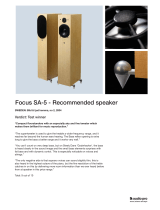Equipment Report
are responding to a bank robbery
where hostages have been taken
and activity at the crime scene is
becoming increasingly chaotic. To
reflect that fact, the sound design-
er builds in more and more layers
of soundtrack information as the
scene unfolds—the sirens of arriv-
ing police cars, the piercing horns
and deep-throated diesel roar of
emergency vehicles, the garbled
back-and-forth conversations of
law officers on police radios, and
snippets of frantic conversations
from onlookers. With some receiv-
ers this scene could potentially
turn into a cacophonous mess,
but through the Rotel each indi-
vidual sonic thread remains clear
and well delineated, with every ele-
ment maintaining its distinct flavor
even as new elements are added.
Interestingly, each sounds
occupies its own tightly
focused position within
the larger sound field, so
that as the sound track
becomes more and more
complex, listeners can
track specific sounds not
only by timbre but by their
locations. But just when
it seems the soundtrack
can’t get much more elab-
orate, director Spike Lee
cuts away to nearly silent interior of
the bank. The contrast is delicious.
But later on, Inside Man also
gives the Rotel a chance to flex
its dynamic muscles. Detective
Keith Frazier (Denzel Washington)
has deduced that the bank robber,
Dalton Russell (Clive Owen) has a
hidden agenda and that the rob-
bery is not what it appears to be.
But before Frazier can act on his
insight Russell decides to change
the game in a violent way by shoot-
ing one of the hostages. Spike Lee
captures the horror of the moment
by showing that the events lead-
ing up to the shooting are unfolding
more rapidly than Frazier can fol-
low. One moment Frazier feels he
has handle on the situation, and the
next we hear the hard, sharp, vi-
cious report of a gunshot as we see
a police video of a hostage being
shot in the head and then slowly
falling to the floor. The Rotel did
a very good job of capturing the
abrupt transient “bark” of the gun-
shot, and then the ensuing whirl-
wind of sounds from within the po-
lice van as the officers struggle to
comprehend the murder they have
just witnessed.
MUSIC PERFORMANCE
A record that’s been in frequent ro-
tation on my various A/V test sys-
tems of late is jazz vocalist Norma
Winstone’s Distances [ECM]. A
favorite (and very revealing) track
from the album is “Mermaids,”
which is chockfull of sonic riches
from end to end. The track opens
with a variegated mix of percus-
sive sounds—deep piano strings
that sound as if they have been
plucked or struck, hand slaps, and
the like—all of which seem to float
in space as their notes slowly echo
and then fade in the confines of
what is plainly a reverberant re-
cording space. The Rotel made a
delightfully vivid sonic potpourri of
those opening percussion notes,
and then got even better when
Winstone’s voice, accompanied
by Glauco Venier’s haunting pia-
no, enters the song. Winstone’s
voice is creamy smooth, yet by no
means saccharine sweet, and full
of subtle and evocative twists and








